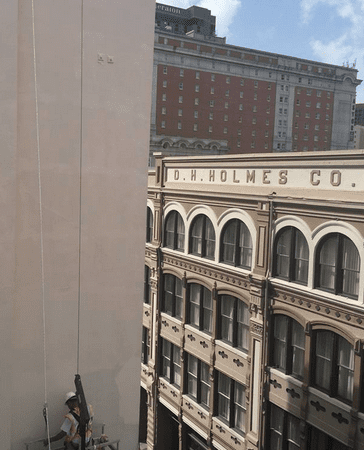
Lafayette 337-329-8445
New Orleans 504-229-2083

Lafayette 337-329-8445
New Orleans 504-229-2083

Swing stage scaffolding is exactly what it sounds like, a platform stage that swings from a building. This elevated work platform is supported by suspension lines and is used primarily on high-rise buildings. Safety beams and canter weights are used to suspend our scaffold from the roof, and the platform is then raised and lowered with automatic hoisting equipment. It is used to transport workers, their tools, and materials at an appropriate height to perform a job.
Swing stages are the most common type of suspended scaffolding used in the painting industry. The first reason is their versatility. Swing stages can be easily installed, dismantled, and relocated from place to place; they have a very user-friendly operating system. They also make it easier to access areas that may be inaccessible for other types of scaffolding or man lifts.
This is why they are more notably used by window washers and painters on tall buildings. At JMA Painters, we use them on commercial properties like mid and high-rises, offices, warehouses, and schools. Another very important reason is their safety. Just as any other type of scaffolding, swing stage scaffolding is safe when all of the right precautions are taken to ensure proper use.
Before starting your painting project with Swing Staging, it’s important to take necessary precautions to ensure safety and efficiency.
Here are essential tips to consider:
One rule of thumb to ensure your scaffold’s safety would be, to raise the scaffold 6 inches off the ground and jump. If there are no visible signs of distress or sounds, your scaffold is sturdy. I know this may sound dangerous, but put it this way, you would rather fall 6 inches off the ground than 6 stories, wouldn’t you?
Scaffolds and all of their components should be able to hold 4 times their maximum intended load. So for instance, if a scaffold was meant to hold up to 1,000 lbs then it should be able to hold 4,000 lbs without failure. This is not to say test it out!
Whenever you are using a suspended scaffold system you must use a personal fall-arrest system for each worker on the scaffold.
A personal fall-arrest system consists of five main components:
It is important to remember that workers should be independently tied off from the scaffold in case of failure of the suspended scaffold system. Workers should always ensure their free-fall distance is limited to 6 feet or less by following proper fall-protection techniques. Remember, a falling worker can fall up to 18.5 feet in a personal fall-arrest system with a lanyard; so if the ground or any other object is within 18.5 feet of the anchor point, use an SRL or another shortstop fall protection system.
Here at JMA Painters, we take safety very seriously. This is why we choose to have each one of our field workers extensively trained in all types of scaffolding, including suspended scaffolding. For more tips on scaffolding safety go to www.osha.gov or our website at www.jmapainters.com. Contact us today to learn more about our services.